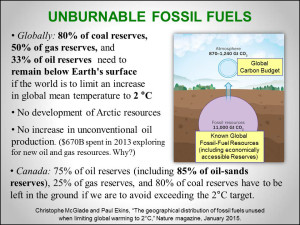Unburnable Fossil Fuels Necessitate Zero-Carbon Goals

In their article in the January 2015 of Nature magazine, “The geographical distribution of fossil fuels unused when limiting global warming to 2°C,” Christophe McGlade and Paul Ekins confirm our global carbon budget. They quantify unburnable fossil fuels both globally and regionally. The writing is on the wall. To prepare for an inevitable low-carbon future, smart companies will integrate zero-carbon goals into their business models.
The authors estimate that there are 11,000 gigatonnes of carbon dioxide (Gt CO2) trapped in known fossil-fuel resources in the world. By 2050, we can only add about another 1,100 Gt CO2 to the atmosphere before we exceed a 2ºC rise in the average global temperature above pre-industrial levels. That is the upper limit beyond which climate scientists and policy makers unanimously agree that there is at least a 50% chance of catastrophic and irreversible global climate destabilization. That means that 90% of the CO2 that is trapped in worldwide fossil resources must stay in the ground as stranded assets.
McGlade and Ekins then go further and make it personal. They distribute the carbon budget by allocating how much oil, gas, and coal extraction from reserves is allowable in various regions. Canada’s unburnable carbon allocation is shown in the adjacent figure. Sobering.
Operating within a carbon budget changes everything, not only for fossil-fuel companies but for any company that directly or indirectly use fossil fuels as an energy source. To future-proof themselves, companies must wean themselves off fossil fuels and prepare for a low-carbon future. They also need to avoid jeopardizing their social license to operate by contributing to climate risk through indirect emissions in their value chains. That’s why there are four zero-carbon goals among the 28 science-based goals in the Future-Fit Business Benchmark:
- All energy is from non-polluting, carbon-neutral sources
- Company operations emit no greenhouse gases
- Products emit no greenhouse gases, both during use and end-of-life processing
- All tier one suppliers are future-fit, which means they attain the above first three goals themselves and for their tier one suppliers, and so on.
Your feedback on these goals and others in Public Draft 1.0 of the Future-fit Business Benchmark is welcomed. In case you are not familiar with the benchmark, my co-author of the Public Draft, Geoff Kendall, provides a good overview in his recent blog for Sustainable Brands.
Over the next couple of months, I will feature a few of the goals in the Future-Fit Business Benchmark in my blogs, using recent reports to reinforce why they are needed and pointing to Geoff’s blogs for additional context.
Stay tuned …
Bob
The above slides will be added to the next release of my Master Slide Set, to which you are invited to subscribe.
Please feel free to add your comments and questions using the Comment link below. For email subscribers, please click here to visit my site and provide feedback.



